Collectors and comic aficionados are quick to knock Canadian war-time black-and-white comics to the lower rungs of the comic book quality ladder and, of the four main Canadian comic book publishers, Anglo-American comic books are seen to occupy the lowest of those rungs. Anglos only had two-tone, newsprint stock covers until after the war. They didn’t have stand out heroes like Nelvana or Brok Windsor and, for a number of years, relied on redraws of American Fawcett scripts for the major part of their content. Anglo-American comics have always been less collectible than those from the other major Canadian publishers. Perhaps also because they generally seem to be more common, especially the later, post-war colour issues.
This is a headwind I think collectors should plow against.
Harlan Ellison, who grew up in Plainesville, Ohio, just outside of Cleveland, was in a locale as an eleven-to-twelve-year-old where he could encounter some of the post-war colour Anglos which were, in fact, being printed in Cleveland at that time. In his Introduction to John Bell’s 1986 book Canuck Comics (Matrix Books, p. 9), Ellison offers up the following:
America may have done it first, but I’ll stack up a stack of Grand Slams and Three Aces against almost any title of the period and betcha nine-to-five the happy content is equal or better than the Yankee product.
Quite an endorsement! Here is an illustration from that same book, Canuck Comics done by Ed Furness which features the whole stable of Anglo-American characters orbiting around Freelance:
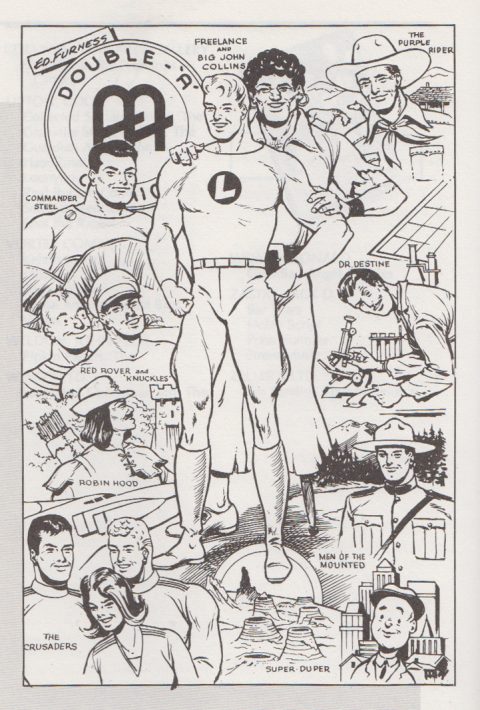
I remember Captain George Henderson, who was the first real Canadian champion of pop culture during the 1960s and early 1970s, saying that Freelance was Canada’s most popular comic book hero during WWII. Not Nelvana, not Johnny Canuck, not Brok Windsor, but Freelance. Without a doubt Freelance, given Ted McCall’s involvement, was the best-written Canadian comic book hero of the period. It certainly had the longest continuous run of original material with 35 issues, almost all containing at least three (early 64-pagers had four, but the four Freelance-Robin Hood books had only one) full Freelance stories. A Freelance compilation along the lines of those already done for Nelvana, Johnny Canuck, and Brock Windsor would need three volumes.
In my last few columns, I’ve looked at books from that first, formative year in Canadian comics—1941. Books from this start-off year for Canadian comics are special and amongst the hardest to come by. The first issue of Freelance is one of these and was cover-dated July-August 1941. It would probably be sitting on the stands next to the fifth issue of Better Comics, the third issue of Robin Hood Comics, and the second issue of Lucky Comics. Adrian Dingle would have been laying out the first issue of Triumph-Adventure Comics and getting it ready for the printer while Edmund Legault would have just been approaching Cy Bell with his idea for a comic book for Bell’s Commercial Signs company that would eventually become the first issue of Wow Comics.
As Bob MacMillan tells us in his “The War Years: Anglo-American Publishing” from John Bell’s Canuck Comics (Matrix Books, 1986), at the time of the passing of the War Exchange Conservation Act (Dec. 6, 1941) Toronto Evening Telegram journalist Ted McCall, held the rights to a half-dozen years of his daily strip about Robin Hood. McCall approached Harold Sinnott, head of the Sinnott News magazine distributing company based in Toronto about issuing them in comic book form and Anglo-American Publishing Ltd. was born with that tabloid-sized first issue of Robin Hood Comics.

With Robin Hood launched, McCall wasn’t satisfied and wanted a contemporary hero who could take on the Nazis. He hit upon using an idea he had probably come across while doing research on the medieval world of Robin Hood. In that world, there were a few mercenary knights not attached to any liege, who could be hired temporarily as bonus soldiers to fight any battles as they cropped up. These knights were called Free Lances. McCall wanted a hero like this who had no fixed boss and he called him ‘Freelance.’ To make him more intriguing, McCall also gave him an obscure past.

Syd Stein, the artist with whom McCall was working on his daily Robin Hood strip, and the third artist for that strip, put McCall in touch with his friend Ed Furness. With this connection, the first issue of Freelance Comics was born.
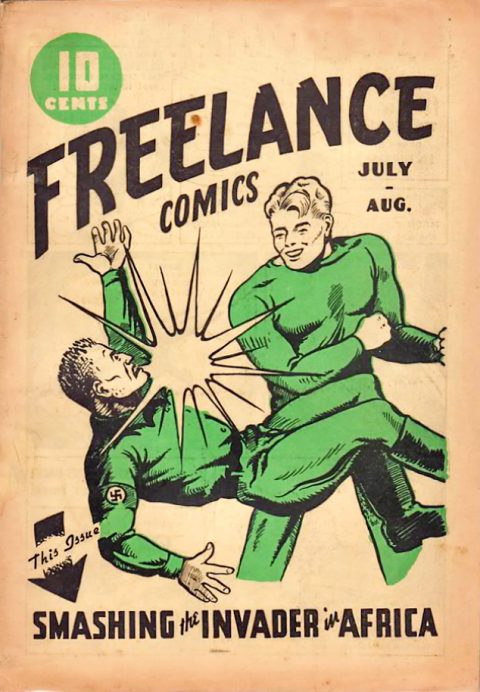
In this first issue, the hero who was to become Freelance is just called Lance and he doesn’t yet have that signal “L” emblazoned on his chest. We first encounter him flying his plane into an Arctic mountain crater hidden to the outside world by perpetual blizzards. That crater, we learn, contains the jungle world that is home to the tribe that raised and trained him from a young child after his father, an outsider to the tribe as well, had died. We also learn that Lance was sent out into the greater world under a false identity, according to his father’s wishes, to receive his education.
He is returning to his real home, in the face of a World War, to receive counsel about his desire to fight against the Dictator who is trying to conquer Europe. The tribe’s leader eventually gives Lance his blessing and Lance flies out of the crater and south to begin taking on the Nazi enemy.
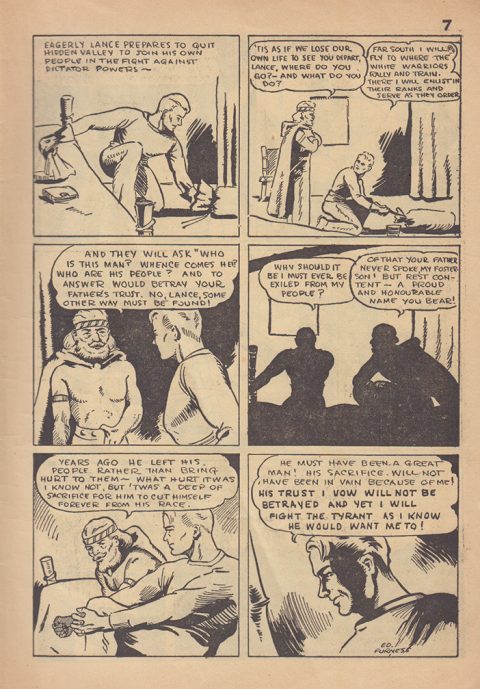
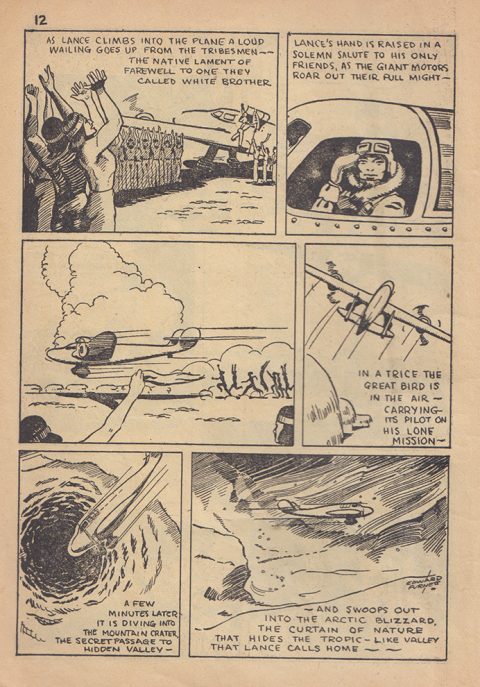
After many hours of flying, Lance encounters a British freighter that is being unknowingly stalked by a Nazi U-boat. Because his plane has no markings, he is fired upon by the freighter, but Lance manages to get a message on board on board informing the ship that they are being pursued by a U-boat. The freighter immediately takes evasive action and the U-boat surfaces to pursue it. To sum things up, Lance crashes his plane into the U-Boat, destroying it and saving the freighter. He lives through this and is rescued out of the water unconscious by the freighter.
Following a number of days of recuperation in the ship’s sick bay, Lance decides to jump ship at night as they approach the coast of Africa and his odyssey across the various WWII theatres of war begins. He takes on Nazis in the jungles of Africa and, in the last story, supports the British against the Italians in Ethiopia.
The cover of the second issue is the first appearance of any sort of “L” emblem. Lance is in Iraq dressed in Arab garb and it appears as an “L” inside a shield-type container just over his heart. Inside the issue itself, it doesn’t appear until the fourth, and last, story and there also as a shoulder patch on Lance’s upper left arm.
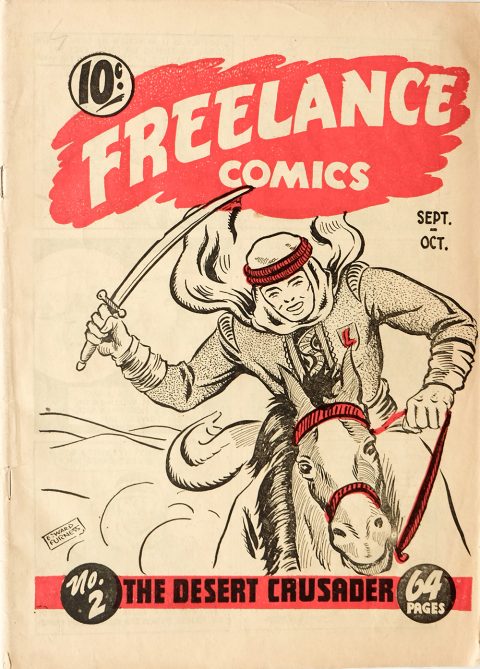
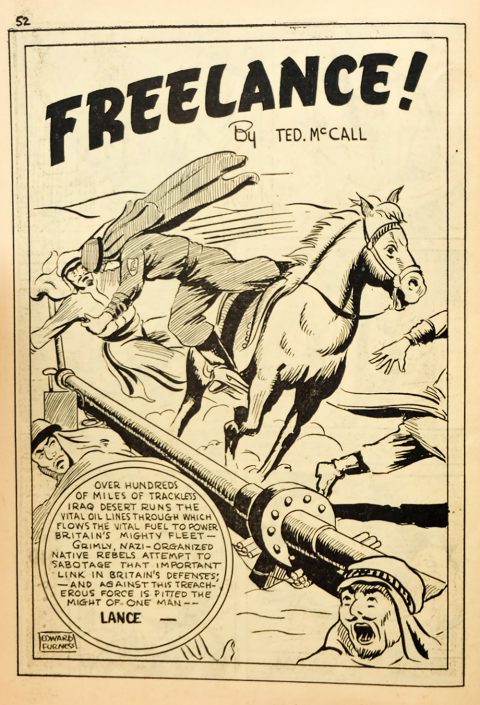
The cover of issue three gives us the Lance we all know and love outfitted with one of the most common hero costume features in WWII Canadian comics—jodhpurs and riding boots south of the belt. These are topped off with a long-sleeved, crew-neck T-shirt with an “L” emblazoned in the centre of the chest. We can’t be sure of the colour scheme because the black-and-white world of Canadian war-time comics was essentially colour blind and Anglo-American doubly so because its wartime covers were only two-tone.
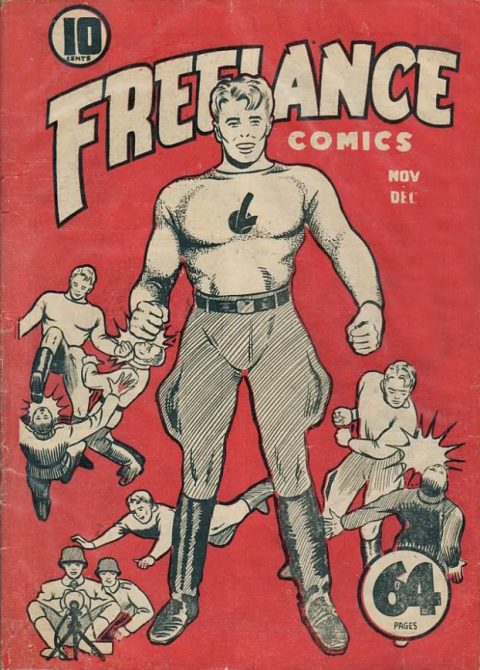
We don’t find out that Lance’s top is red until the summer of 1945 and Freelance Robin Hood and Company comics No. 27 which is the first colour appearance of Freelance.
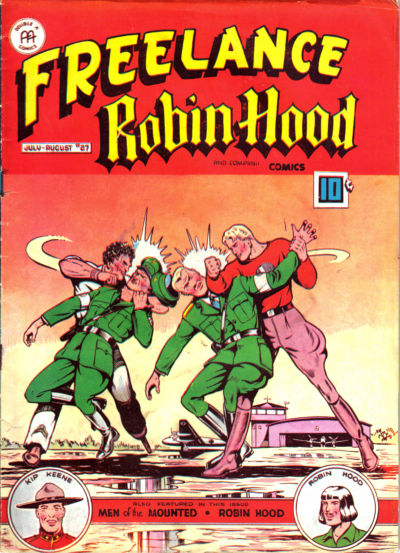
However, the anomaly is this: throughout the rest of the first dozen issues, while Lance’s exploits cut a swathe through Crete, France, Holland, and Norway, he never has that “L” on his chest. Well, that’s not exactly right, it does appear once on the back cover of Freelance Vol. 1 No. 4 in an ad announcing the arrival of Captain Marvel and the Fawcett mainstay characters to the Anglo-American fold. I don’t know what Messrs McCall and Furness were doing here, but I hope that we can find out one day.
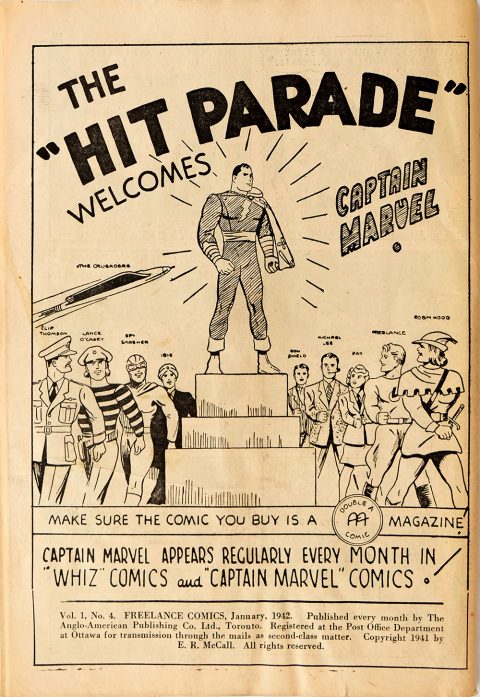
It’s important to realize that Ted McCall, though he would become a managing editor for the Toronto Telegram, was just a writer for Anglo-American. His publisher was Harry Sinnott and he had hired John McKellar Calder as the overall editor for Anglo-American comics. “Jack” Calder was born in Edinburgh, Scotland in 1904 and came to Canada with his mother as a ‘Canadian Military Dependent’ at the end of World War I in 1918 as a fourteen-year-old. He was in his late thirties when he started working for Anglo-American comics. Calder created the characters Michael Lee, Terry Kane, and Purple Rider under the name of ‘Jay’ McKellar.
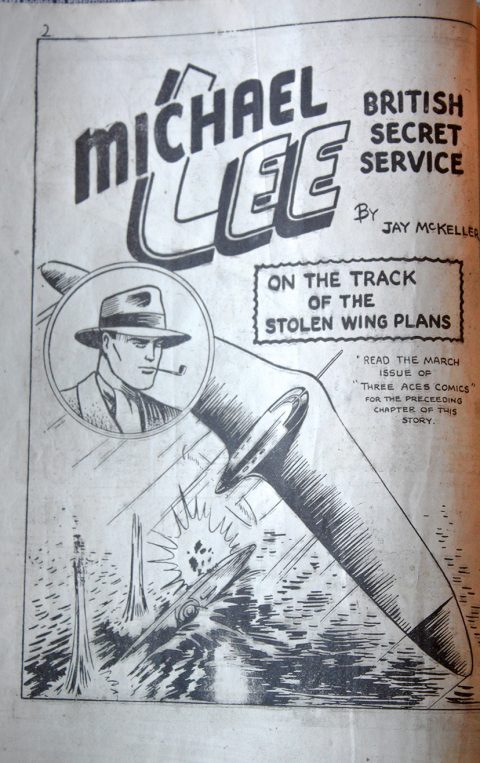
By the end of the first year, Calder suggested to McCall that Lance should have a sidekick and in Vol. 1 No. 9, Freelance meets up with Big John Collins. Big John clearly seems to be a derivation of ‘Little John’ from the Robin Hood mythos that McCall had been steeped in during his run of the Robin Hood daily strip. Freelance encounters him as a tough pirate-type character on a south seas island. The Madagascar pirate, Big John Collins, has swarthy skin, hoop earrings, and a peg leg and Freelance bests him in a fight just in the same way that Robin wins over ‘Little John.’
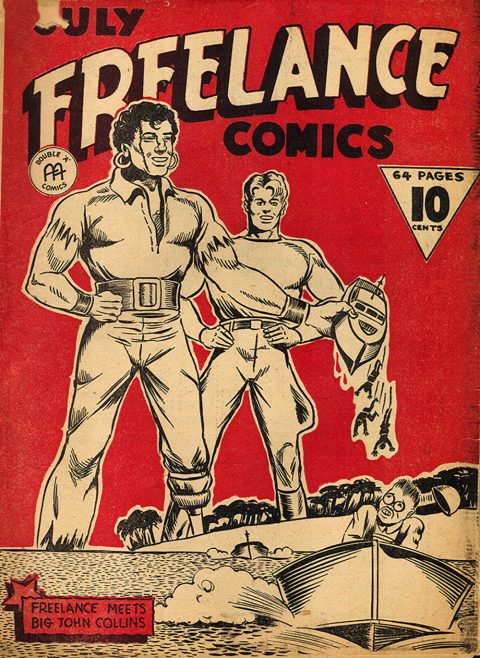
Soon after, and before the end of the first volume of Freelance Comics, Calder also suggests to Ted McCall that Freelance get a Russian accomplice. The Russians were part of the Allied Forces and were engaging the Nazis on the Eastern Front and Calder felt that their contribution to the war effort should be recognized. With this, female Russian operative, Natasha, enters the picture. This trio, Freelance, Big John Collins, and Natasha, though more intermittently, comprises the hero team of Freelance comics for the rest of the run. Though Big John Collins made the cover with his first appearance and many more covers thereafter, Natasha doesn’t get a cover appearance until the 30th issue and then only one other in the back seat of a jeep with the issue right after that. I wonder what would have happened to Natasha if Freelance Comics had gone on for another half-dozen years and the WWII comradeship with the Russians became inverted.
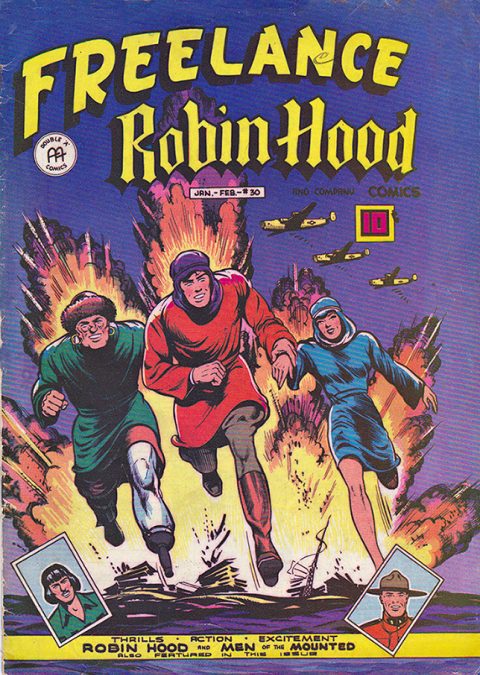
After the war, Freelance, Big John Collins, and Natasha help clean up remnants of Nazi stragglers and revivalists but seem to fizzle out a little bit without the proper Axis as a nemesis and the live electricity of the European and Pacific theatres of war in which to operate. He does make it to North America in the last issues fighting alongside hillbillies in Tennessee in issue 33 and has adventures in the North West Territories in the last two issues, but he never sets foot in any of the nine Canadian provinces.
Here are a couple of pages from an Ed Furness sketch book that is in the posession of one of the best-known collectors of Canadian war-time comics:
Some attention may be brought to the similarity in appearance of Freelance (first appearance July-August 1941) and Quality’s Captain Triumph (first appearance, Crack Comics 27, January 1943). The question is whether or not Captain Triumph can be seen as somewhat of a swipe of Freelance? The powers and origin stories are, of course, completely different, but visually, there’s a striking similarity. Both are blond, have red, crew-neck tops (Freelance’s is long-sleeved, Captain Triumph’s is short-sleeved), jodhpurs (Freelance’s are brown and Captain Triumph’s are white) and riding boots. Freelance’s name is sometimes given as Lance Valiant and the name of the living twin who takes on his dead brother’s spirit when he becomes Captain Triumph is Lance Gallant. Of course, this could be a complete coincidence.
Throughout his run, Freelance is a man without a real back story tying him to any country. He is a war-time hero created by Canadians but otherwise not identifiably Canadian. He is a man without a country who fights on behalf of the oppressed. From early issues, he has had a calling card which depicts a waving stick figure riding a soaring lance which he left to indicate that Freelance had been the source of a particular Axis misery. This emblem and a sort of summary creed appear on the inside front cover of Freelance – Robin Hood Comics 27 (July-August 1945) which was the first of the four combined titles and contained the first full-colour appearance of Freelance:
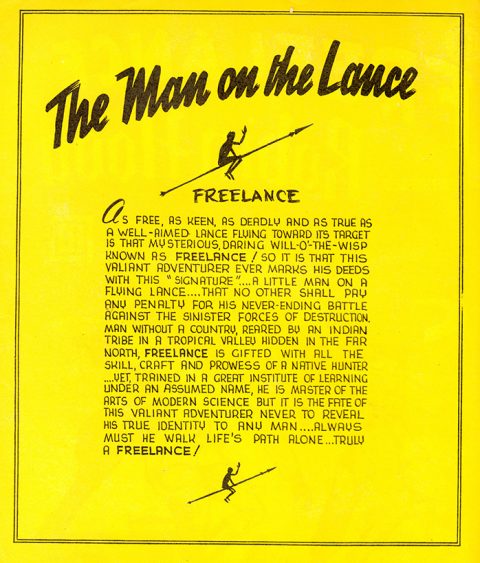
I suppose this ideal of operating in anonymity and self-effacement—a sort of national ‘humbleness’—might be construed as an essential Canadian quality and to that extent we could lay an additional claim to Freelance as a Canadian superhero, but I think that this is an unnecessary stretch. Ted McCall and Ed Furness’ Freelance is a Canadian superhero in all the senses of the word. I remember a peripheral story from one of my interviews for my work on my book Heroes of the Home Front in which the interviewee recalls a cousin who was part of the Canadian invasion force on D-Day seeing a half-buried copy of an issue of Freelance Comics in the grit of the beach. I don’t care if the story is true or not, but it’s a great note to end on.
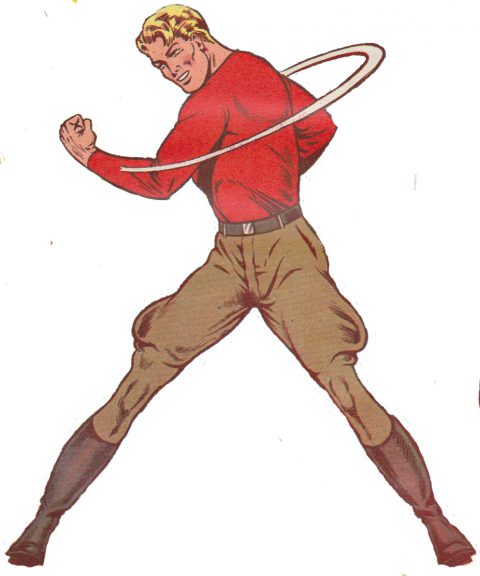
NEWS ITEM: I want to draw readers’ attention to what looks like a great exhibit coming up at the Art Gallery of Hamilton at the end of June and running through the rest of the year. It’s called THIS IS SERIOUS: Canadian Indie Comics and is co-curated by Hamilton graphic novelist Joe Ollman. Great chance to see a bunch of Canadian indie comic and graphic novel original art put together by knowledgeable people.

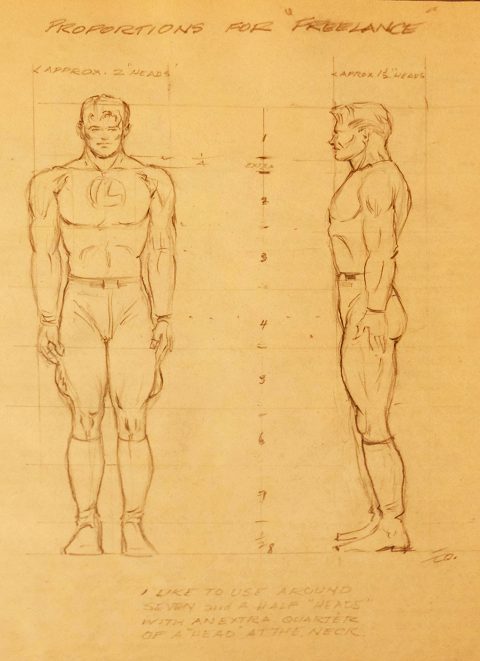
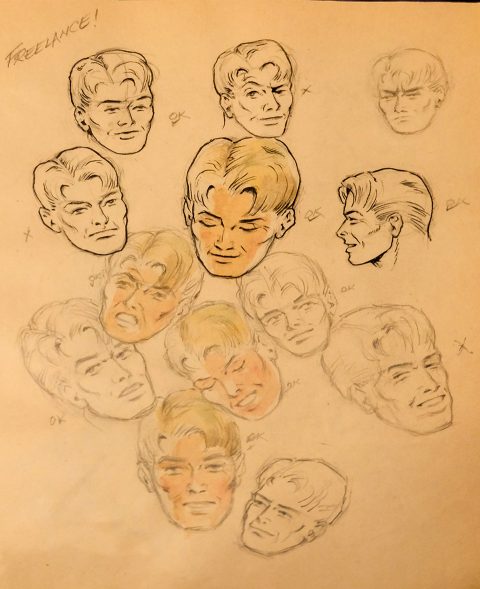
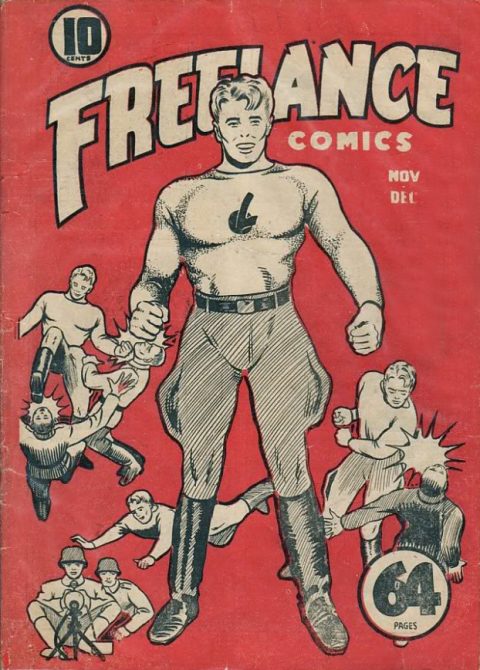
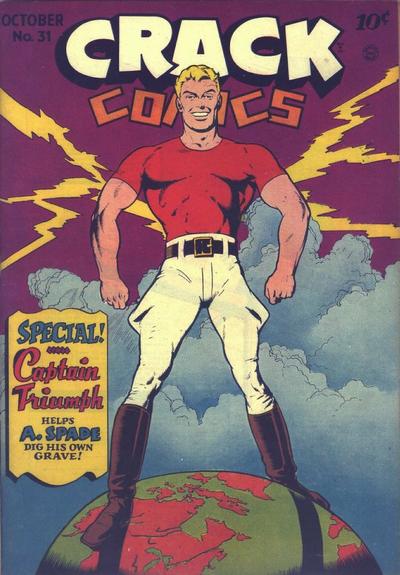
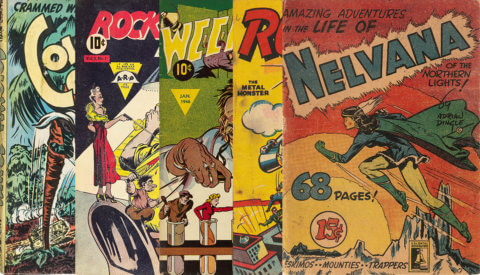
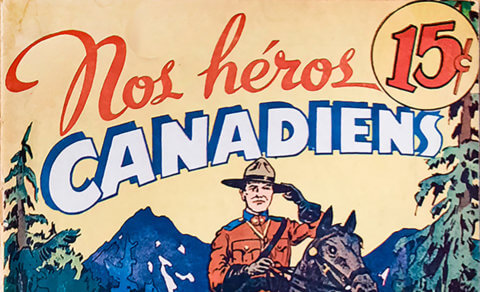
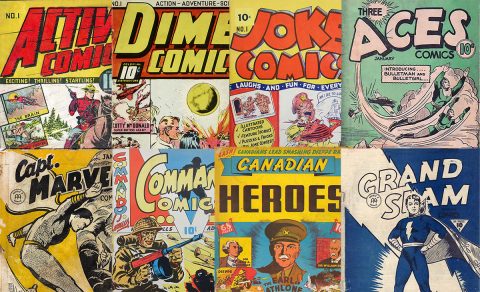
4.5
One point worth noting, those later color AA titles might be good entry-level comics for comics fans curious about the WECA. As I recently noted to Ivan, you can still score these for bargain prices, i.e. under $100 or even under $50. They are listed in Ivan’s Price Guide for $100-$250-500, for the most part, in GD-FN-VF/NM, far less than most earlier b&w titles.
That’s very interesting comparing Freelance and Captain Triumph. Would have no idea if you hadn’t pointed it out. After all else, it seems coincidence…but the similarity of the names, seems a step beyond. I wonder, it’s very possible the U.S. creator swiped it. Those covers are also so close, right down to both heroes’ heads overlapping the logo….
Timely article, Ivan. There’s a group (stack? horde? bunch?) of AA Freelance comics up on eBay at the moment mostly from Canadian sellers (a couple from UK,USA). Starting bids from $200+ (issue #27 FL/RH) to $10,000+. A bunch of other vintage Canadian comics too. Hurry! 🙂
That colour punching Freelance cover looks pretty good, there’s a couple of those up.
_________
I see scans, where are the 3 collected books? Again.Take. My. Money. (And I’d wear a Freelance t-shirt too.)
Thanks for the interesting write up. I’d like to read Freelance, he’s a somewhat mysterious unmasked character operating in an unusual theatre, good stories it seems and Furness’s art IS top notch. I don’t mind that he’s not an overtly Canadian character. Captain Triumph can’t move his arms but looks dynamic especially with the colour art. Freelance seems more naturally realistic. Good comparison between the two.
How many issues are available, would a publisher be able to do the full run? Just now news to me (since my delving into old comics) is Dark Horse Archives has been publishing hardcover editions of WW2 Fawcett comics such as Captain Midnight and The Green Lama (from what I gather complete issues, not just the lead character). Wonder if they would be interested?
Nice tip, Tim. I went and looked….Some amazing books to see all at once. But they all seem pretty costly. The seller seems a little unsure of his grading, which is scary dealing with someone unknown. I have all the color Anglo-American books already, all the cheaper ones there.
Just got an early b&w Freelance a few days ago. If my pockets were deeper….some of those Freelance covers, like the ones Ivan showed us, are really nice.
To play the ‘devil’s advocate’ for a moment here, some Americans claim (and/or imply) that the later Double A characters were created by Otto Binder out of the C.C. Beck, Pete Costanza studio. Check out especially Jim Steranko’s History of Comics for some comments on this.
There’s a mention in the Overstreet Price Guide #15 that says “Beck-Costanza provided Canadian publisher Jack Calder with special scripts and characters, solely for the Canadian market.” I’ve yet to see a bunch of actual proof either for Calder or Binder coming up with the creation of The Purple Rider and the like. I do note that after a number of years the memory of details get ‘hazy’, as C.C. Beck also says in that OPG that the Canadian version of Captain Marvel was renamed ‘Lightning’ (??). I’d love to see comments on this.
hi Bud. I think I’d like to have one or two (rabbit hole ahead) but yeah, no deep pockets. Didn’t read all the details of the listings, just sort of oogled the covers and whimpered at the prices. What do you do? The guide is only a guide and some people want more so more power to them. Wait until WECA get really hip. I can only collect by proxy with new books.
Used to Steranko’s Histories, jim b. They were a neat introduction to a lot of characters I never heard of (which is still a joyful problem). Learned about a bunch more in Ivan’s book (The Wing, Thunderfist, Sooper Dooper etc.) and can see the DCM is a wonderland of terrificness (The Sparkler, The Human Bomb… such inventive fun). So info on that situation you describe would be interesting to find out.
Bud and Tim–I always appreciate your comments and I am thankful that my columns may have sparked some interest in our old Canadian war time comics in you both. That certainly was my hope and intention when I began writing it. I wish more of the American Fawcett collectors were aware of the redrawn scripts that appeared over a three-year period in Anglo-American comics. The seller that puts the largest number of WECA comics up on eBay is Bruno from Laval, Quebec and is known for his very high asking prices. I’ve only met him once at a Montreal Con and he’s a nice guy, but I’ve never gotten why his WECA listings are priced so high. Tim, the very first WECA t-shirt I made up for myself was a Freelance shirt and I still have it. I’ll have to send you a pic.
Interest in WECA books has really grown in these past half-dozen years and I think there is still room for it to grow. The only thing that is holding it back is the obscurity of the books (which I am trying to address) and the available supply (most are so damn hard to find).
Jim B.–Thanks for bringing attention to these references in Steranko and the OPG. I don’t think I’d ever come across them. I looked them up and the one from Steranko’s “History” (Vol. 2 p. 12) is: “… In the Canadian Anglo-American books, he [Binder] launched Commander Steel, The Purple Rider, Terry Kane, The Crusaders, and Rocket Rex.” Steranko doesn’t offer any source for this information and I don’t know what he based it on. Clearly, however, The Crusaders were with Anglo from the first issues of Three Aces and Grand Slam, just before Fawcett came on board and I’ve no idea who “Rocket Rex” is. My info comes from Bob McMillan and his taped interviews with Ed Furness–which I hope will eventually be published. You are right to say that memory fades and alters over time and I wonder if we can ever straighten it out.
The full quote from OPG 15 by Jerry De Fuccio runs from pages A-85 to A-86: “Beck and Costanza provided Canadian publisher Jack Calder with special scripts and characters, solely for the Canadian market. When Calder purchased rights to Fawcett comic characters, however, by law, even Captain Marvel had to be redrawn by Canadian artists. Script, but no foreigh art, could be imported. Calder’s comic books wound up on U.S. newsstands nevertheless. As I recall, in Canada, Captain Marvel was renamed “Lightning.”(And printied on pink-tinted stock. Holey Moley!). This is not a Beck quote, while most of the article seems to be an interview with Beck. The recollection of “Lightning” seems to be a recollection by the author and not Beck. Puzzling in any case. I think the “special scripts and characters” only refers to the regular Fawcett stable and not outrightly new characters created by Fawcett but never published by them. More mysteries that I hope can eventually be cleared up.
Ivan, forgot to say thanks for posting the Freelance character design pages too. As an artist i always like to see the process sketches and ideas of the comic artist’s thinking. A man in a canoe on a lake is a very Canadian iconic image, almost as much as a Mountie, but the forest on fire and an erupting volcano make that a great splash panel. The story prologue gives it another boost of “Wow, I gotta read that!”.
“…my columns may have sparked some interest in our old Canadian war time comics in you both.” You could say that! Membership card and badge, anyone?
Re: higher than guide pricing. Met a fellow at Calgary Comic Expo who had a booth of really nice photocopies of Marvel covers under plastic. Got to talking and his reasoning was you could ask to buy the comic but he sold at triple the guide because his were pristine like right off the press. He apparently had spent a lot of time and money on constant upgrades over the years. Very financially focused towards his retirement even though he was a younger man than myself. So, very smart that way, I guess.
(Well, I could do my bit for un-obscuring the WECA by wearing them. People might ask “who’s that?”. Does one need to acquire license to make 1, one, single, solo, not-for-sale homemade shirt? I was thinking one for each character, or a group shirt of say one major character from each of the publishers. And the publisher logos of course, plus appropriate credit text for artists.)
As much as I love to hear that someone swiped a Canadian character and published it in the US,I’m not surprised since the entire WECA era was an industry rapidly built from the ground up with nothing more than the US counterpart as an example of how to do it.
I would think US artists and publishers were quite aware of what was going on at that time, and its affect on their income.
We learned from the best and at the same time gave them a unique perspective in characters that I believe would have done well if they were distributed in the US with the same quality and print with just a little more investment in the product, and at the same time they were published in Canada.
I like the idea of the t-shirts, Ivan, even though I’m not, a t-shirt wearer, EVER (unless its really good and then and only then over a long-sleeved, fully tucked in, shirt).
But I’d love to start a line of leather vests with Canadian Comic logos, Characters and covers.
I’d start with Canada Jack since he only wore T-shirt while riding a motorcycle on the Adventures of Canada Jack cover.
When it comes to profit over promotion, I feel that what we, as those in modern day that are educating and promoting Canadian Whites material, that is largely now in museums and libraries of educational institutions thanks to people like Michael Hirsh and Patrick Loubert we are in a period of preservation and education of our history.
I’m doing ,my best to digitize every WECA Canadian White I can to educate and promote their unique place in our history.
Lest we forget
Another great article. Just wanted to say thank you to you Ivan.
Your articles are always interesting and it is amazing that for a fairly short period of time (WECA years) there is always something new to learn.
Freelance is a character I have read about, but always thought he was from Antarctica not the arctic.
As for Freelance t-shirts I designed a shirt years ago on Red Bubble.
When I first saw the character I always wondered what the “L” stood for and imagined his enemies calling him various names based on the shirt.
A Freelance collection would be great.
Active-Jim, great idea for a full line of WECA clothing–covered head to toe in WECA designs. It will be a great service to have all the WECA books digitized. I know that Robert Pincombe has been doing the same for a number of WECA books as well. You should check in with him and see what’s already been done.
Peter, it’s fun to be working in WECA archeology because it’s still a relatively unexplored world and there’s tons of stuff to discover. When I finally stop doing this column (and I feel like that every other month). It might be worth it to gather the columns up and them into a single volume.
As for the “L” on Freelance’s shirt, I’ve always assumed it stood for “Lance” which is what he was–a “free” “lance” protecting and fighting for the weak. His first name wa\s “Lance” as well, so maybe it played on both things.
Another “Freelance”!? Looks similar doesn’t he but without jodhpurs.
https://www.ebay.ca/itm/Adventures-of-Captain-Tootsie-1-Superior-CANADIAN-EDITION/252471667457?hash=item3ac87beb01:g:jKQAAOSwSv1Xko2q
Yes, Ivan, to your book of your column. We’re not getting any younger. Good information and history here, just edit out what you’ve covered in Heroes. Have you heard of blitzprint.com (in Calgary)? Maybe instead of going all the way to China for printing.
I’ve just bought The Quality Companion book to be a companion book to Heroes, it covers Quality’s US war era comic characters with history and 10 comic stories. There is a strong tie between C & US comics of the era – joyful, unbridled, creative enthusiasm and fun!
Do you know which Canadian comics and characters are in public domain and NOT trademarked? Might be worth knowing going forward. I don’t know if one can buy trademarks or re-copyright such material but might be worth looking into for retaining the works in Canada. Re promoting Canadian heroes – movie? Nelvana Inc. animated series or specials on the CBC and DVD? Ivan’s stamp set idea? embroidered or silk screened jackets, vests, hats but please no silliness such as “collectible” plastic bags for lettuce (Star Wars did that, yikes).
hi activejim, just a thanks for your personal project to digitize as many Canadian comics as you can and preserving them. It’s nice to know they’re somewhere, with the possibility of being accessible for books like Ivan’s or other things. Cheers!